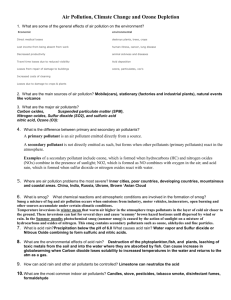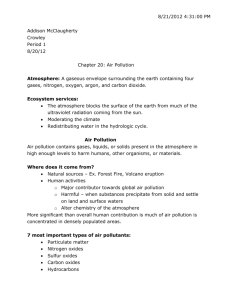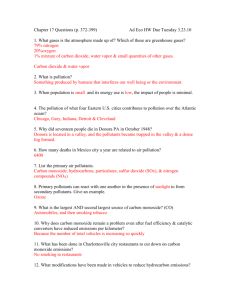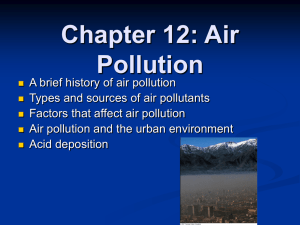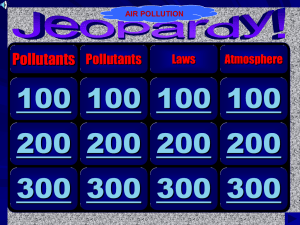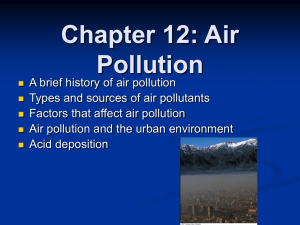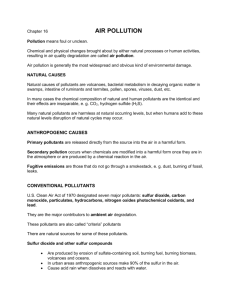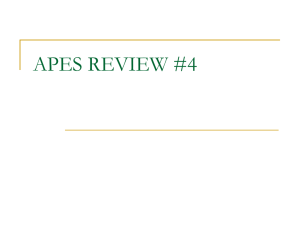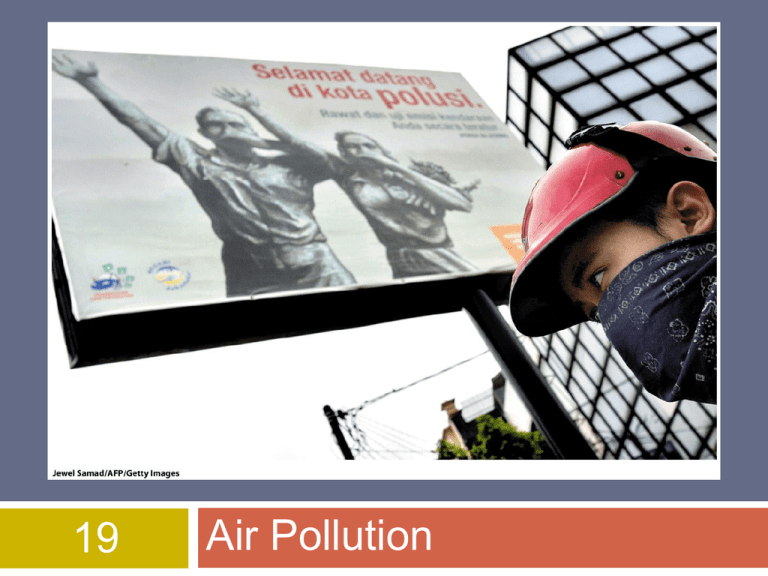
19
Air Pollution
Atmosphere
Atmospheric Composition
Nitrogen
78.08%
Oxygen 20.95% *
Argon 0.93%
Carbon dioxide 0.04% *
Other gases & pollutants
Much
lower conc.
Ecosystem services
Blocks
UV radiation
Moderates the climate
Redistributes water in the hydrologic cycle
Air Pollution - Terminology
Air Pollution
Chemicals
added to the atmosphere by natural events
or human activities in high enough concentrations to be
harmful
Two categories
Primary
Air Pollutant
Harmful
substance emitted directly into the atmosphere
Secondary
Harmful
Air Pollutant
substance formed in the atmosphere when a
primary air pollutant reacts with substances normally found in
the atmosphere or with other air pollutants
Major Classes of Air Pollutants
Particulate Material
Nitrogen Oxides
Sulfur Oxides
Carbon Oxides
Hydrocarbons
Ozone
Lead
Major Air Pollutants
Two main human sources
of primary air pollutants
- Industry
- Transportation
Particulate Material
Particulate Matter
Solid
or liquid particles suspended in air
soil
particles, soot, lead, asbestos, sea salt, & sulfuric acid
droplets
Dangerous
May
contain materials with toxic/carcinogenic effects
Small particles can become lodged in lungs
Nitrogen & Sulfur Oxides
Nitrogen Oxides
Gases
produced by the chemical interactions between
atmospheric nitrogen and oxygen at high temperature
Greenhouse gases that cause difficulty breathing
Sulfur Oxides
Gases
produced by the chemical interactions between
sulfur and oxygen
Causes acid precipitation
Carbon Oxides & Hydrocarbons
Carbon Oxides
Gases
carbon monoxide (CO) and carbon dioxide (CO2)
Greenhouse gases
Hydrocarbons
Organic
compounds that contain only hydrogen &
carbon (ex: CH4 - methane)
Some are related to photochemical smog & greenhouse
gases
Photochemical smog - It is the chemical reaction of sunlight,
nitrogen oxides and hydrocarbons in the atmosphere
Formation of Photochemical Smog
© 2012 John Wiley & Sons, Inc. All rights reserved.
Urban Air Pollution
Photochemical Smog (ex: Los Angeles below)
Brownish-orange
haze formed by chemical reactions
involving sunlight, nitrogen oxide, and hydrocarbons
Pollution is linked to:
Immune system sup.
Inf. of respiratory track
Chronic bronchitis
Increased drowsiness
Impaired reflexes
Ozone
Tropospheric Ozone (Bad)
Man-made
pollutant in the lower atmosphere
Secondary air pollutant
Component of photochemical smog
Stratospheric Ozone (Good)
Essential
component that screens out UV radiation in
the upper atmosphere
Man- made pollutants (ex: CFCs) can destroy it
Ozone Damage to Grape Leaves
Sources of Outdoor
Air Pollution
Affects ozone
in So. Cal.
Two main sources
High temps
Transportation
Hydrocarbons
Sunlight & water vapor
Industry
Sources of Smog
in Los Angeles
Effects of Air Pollution
Low level exposure
Irritates
eyes
Causes inflammation of respiratory tract
Can develop into chronic respiratory diseases
Greater health threat to children than adults
Air
pollution can restrict lung development
Children breath more often than adults
Children who live in high ozone areas are more likely to
develop asthma
Controlling Air Pollution
Smokestacks w/ electrostatic precipitator
Electrode imparts negative charge on the air
pollutants
Negatively charged pollutants are then
attracted to positively charged walls & fall into
collector
Smokestacks w/ scrubbers
Water or other fluid to dissolve particulates
then the water is sent through a filter
Both are primarily used
to remove particulate matter
Scrubbers
Emissions not controlledheavily polluted
Emissions controlled with
scrubbers-only steam
expelled
Controlling Air Pollution
Phase I Vapor Recovery System for gasoline
The Clean Air Act
Authorizes EPA to set limits on amount of specific air
pollutants permitted
Focuses on 6 pollutants:
lead,
particulate matter, sulfur dioxide, carbon monoxide,
nitrogen oxides, & ozone
Act has led to decreases in air pollutants
Most
dramatic is lead - decreased by 98% since 1970
(due to switch to unleaded gasoline)
Ozone Depletion in Stratosphere
Ozone Protects earth from UV radiation
Ozone Depletion in Stratosphere
Ozone (O3) thinning/hole
First
identified in 1985 over
Antarctica
a steady decline of about 4% per
decade in the total volume of
ozone
Caused by human-produced
bromine and chlorine
containing chemicals
(Ex: CFCs)
Ozone Depletion
Hole over Antarctica requires two conditions:
Sunlight
Circumpolar
a
vortex
mass of cold air that circulates around the polar region
Effects of Ozone Depletion
Higher
levels of UV-radiation hitting the earth
Eye
cataracts
Skin cancer
May disrupt ecosystems
May damage crops and forests
Recovery of Ozone Layer
Montreal Protocol (1987)
Reduction
of CFCs
Started using HCFCs (greenhouse gas)
Phase out of all ozone destroying chemicals
This
is underway globally
Satellite pictures in 2000 indicated that ozone
layer was recovering
Full recovery will not occur until ~2050
Acid Deposition
Sulfur dioxide & nitrogen dioxide emissions react
with water vapor in the atmosphere & form acids
that return to the surface
pH scale
How Acid Deposition Develops
Effects of Acid Deposition
Declining Aquatic Animal Populations
Thin-shelled eggs prevent bird reproduction
Calcium
is unavailable in acidic soil
Forest decline
Black
Forest in Germany
Acid Deposition and Forest Decline
© 2012 John Wiley & Sons, Inc. All rights reserved.
Lead (Pb) in the Air
Metal found naturally in the environment as well as
in manufactured products.
“Back in the day” Major source of Pb in the air:
Cars
and trucks
As a result the EPA banned Pd from gasoline
Since the ban 95% < in lead emissions
Today the highest levels of Pd emissions are:
Ore
& metals processing
piston-engine aircraft operating on leaded aviation
gasoline
Exposure to Lead (Pb) in the Air
Causes
Behavior
problems
Headaches
Hearing problems
Permanently reduced cognitive abilities
Effects the - nervous system, kidney function,
immune system, reproductive and developmental
systems and the cardiovascular system
Children
are more sensitive to low levels of exposure
Air Pollution Around the World
Air quality deteriorating rapidly in developing
countries
Have
older cars
Don’t generally have scrubbers (expensive)
Some of the worst cities in world
Beijing,
China
Calcutta, India
Mexico City, Mexico
Shanghai, China
Shenyang, China
Tehran, Iran
Some of these cities
residents only see
sunlight a few weeks
each year
Case-In-Point Air Pollution in Beijing
and Mexico City
Beijing
Mexico City
Long Distance Transport of Air Pollutants
(Pollution - not just a local issue)
Global
Distillation
Effect
Indoor Air Pollution
Pollutants can be 5–100x greater than outdoors
Radon, cigarette smoke, carbon monoxide, nitrogen
dioxide, formaldehyde pesticides, lead, cleaning
solvents, ozone, and asbestos
Indoor Air Pollution /
Radon

